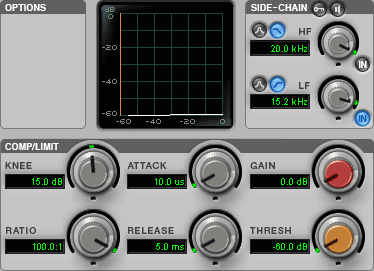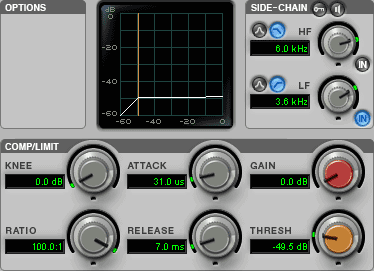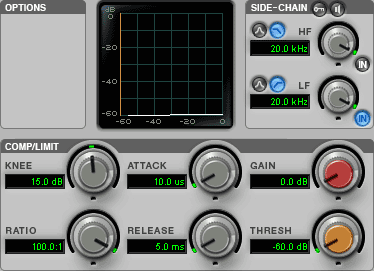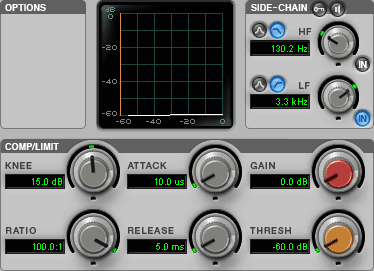Getting the Most Out of Pro Tools
Dyn 3 Compressor/Limiter
Smacking Down Unwanted Noises
The Problem
Ever have to deal with unwanted noises in your tracks, like clicks, pops, plosives, lip smacks, buzzes, and noisy breaths? When you have control over the tracking stage, it's easiest to just nip them in the bud. But when pre-recorded tracks are being delivered to you for editing and mixing, especially when it's live or spoken word material, those kinds of problems are inevitable. With material that is both live and spoken word, the problems are legion.
Using EQ to minimize them has the drawback that it often leaves a brief but clearly audible darkening or thinning of the overall sound. It can also result in a marked, distracting, temporary change in room tone. It's like removing a wart with bleach or acid. Squashing the problem area with an ordinary compressor is no better than simply ducking the overall volume - a really musical sounding compressor is just too coarse a tool to be a viable solution for this kind of surgery. It's like removing a wart with a shovel.
The Solution
Fortunately for Pro Tools users, the Digirack Dynamics Compressor/Limiter III plug-in turns out to be a surprisingly effective tool for treating unwanted noises of a desultory, abrupt, and intrusive nature. The key is to take advantage of four features that are found in this combination only in the Dyn3, as far as I know:
- compression ratios as high as 100:1
- thresholds as low as -60 dB
- attack times as short as 10 microseconds
- a flexible, frequency-dependent sidechain applicable to the internal signal
How It Works
These kinds of noises are spectrally distinct from the surrounding material - typically they have a lot more energy in the extremes ranges of the audio band than the surrounding material has. The sidechain filters allow you to trigger the compressor using the energy only above or below a certain frequency, or only in a certain band between. In combination with the low threshold, you can precisely target very specific audio behavior. The Knee setting further refines the threshold sensitivity and compression behavior, extending the usefulness of the tool to many kinds of situations.
These kinds of noises also tend to have very sharp transients. The extremely short attack time allows you trigger the compression practically right on the noise transient. Because you can specify the attack time very precisely, you can make it fast enough to minimize the unwanted transient(s), while avoiding introducing inverse transients (where the level drops sharply toward zero) elsewhere.
The 100:1 compression ratio is practically infinite - it effectively flattens everything while the compressor is activated. Without the sidechain, the entire processed portion would get completely flattened. Because the attack time needs to be so short, lower frequency material would actually be clipped, introducing severe harmonic distortion and even additional noise. With the sidechain, however, the compressor is only activated at the location of the problem, releasing smoothly immediately afterward. Many times, the compressor action is so fast that it's nearly inaudible psychoacoustically; at the least, it's less audible or less obtrusive than the noise being treated.
Real-world Examples
Below are several examples of the use of the Dyn3 comp/lim to treat different kinds of noise problems. In each case, the Audio Suite version of the plug-in was used to process only the portion of the file that has the noise problem, plus about 30ms on each side to insure smooth crossfading. 160kbps mp3s let you hear the problem and the repair. The actual plug-in settings file is also provided for download to use as a starting point for solving your own noise problems. The mp3s are not level optimized - you will need to adjust your volume. That's so that, if you wish, you can import them into Pro Tools and try the settings on them for yourself to see first hand how it works.

|
Two loud snaps after the word "Paul's." Settings file: |

|
Writing utensil being dropped or nervously struck against the podium. Settings file: |

|

|
Sudden burst of 60Hz hash; loud one after "each," quiet one during the "s" of "tribes." You'll have to listen very closely to hear the second one. The amazing thing to me is that it removed it without hurting the sibilant! Settings file: |

|
Several breath problems solved with my standard starting-place setting.
Settings file: |
DUC ID: daeron80
Written: July 2006
Copyright © 2006, all rights reserved
David's Personal Home Page